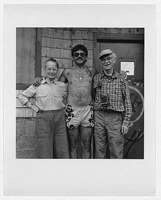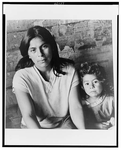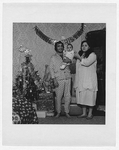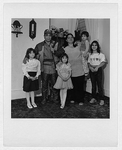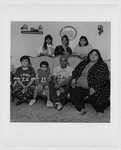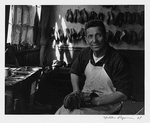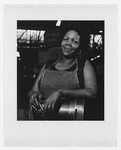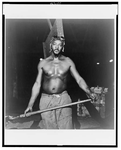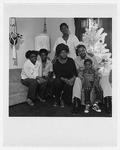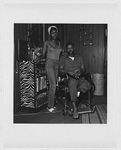Collection Overviews >> Milton Rogovin
Milton Rogovin Photograph CollectionPrints and Photographs Division Social documentary photographs, ca. 1953-2002Background and Scope | The Photographer | The Photographs | Arrangement and Access | Permissions and Credits | Obtaining Reproductions | Related Resources | Selected Bibliography Background and ScopeThe Milton Rogovin Collection consists of approximately 30,000 images (shown in about 29,700 black-and-white negatives, 2,500 contact sheets, and 1,130 signed prints), reflecting the full scope of Mr. Rogovin's six decades in photography. The collection includes his photographs of Buffalo's Lower West Side and the "Family of Miners" series. It also features thousands of images that have never been published--among them photographs of the Yemeni, Chileans, steelworkers, and Native American reservations in upstate New York. From the impoverished neighborhoods around his optometry office in Buffalo, New York, to working class communities around the world, Rogovin's photographs depict overlooked or exploited segments of society with a dedication that expresses his subject's dignity. Rogovin frequently photographed his subjects both at work and at home creating a broader look at their lives. For decades, Rogovin focused on the people and the neighborhood of Buffalo's Lower West Side, resulting in a deeply moving portrait of people's lives over the course of thirty years (1969-2002). The Lower West Side project is an important social document of our multi-ethnic society because of its depiction of the neighborhood's environment and residents. The photographs' far-ranging reach takes in stores, streets, houses, graffiti, and especially the people--from children to the elderly. In 1969 the Library began to purchase individual prints from Milton Rogovin, and had acquired a group of approximately 30 photographs by the late 1990s. In 1999 Milton Rogovin donated much of his photographic archive to the Library. The PhotographerBorn in 1909, Milton Rogovin grew up in New York City and attended Columbia University where he earned a degree in optometry. In 1938, Rogovin moved to Buffalo, New York, to work in an optometry practice, opening his own office the following year. Alongside his practice, Rogovin was socially active in the optometrist union, worked on voter registration drives in African-American communities, and volunteered as the literature director for the local Communist Party. In 1957 when the House Committee on Un-American Activities came to Buffalo, Rogovin was called to testify before them. Rogovin pled the Fifth Amendment, and his trial was widely covered by the Buffalo media, which named him the "Top Red in Buffalo." The adverse publicity damaged his optometry practice.Early PhotographsA year later, Rogovin found a new outlet to express his political concerns. William H. Tallmadge, a professor of music at the State University College at Buffalo, approached Rogovin to take pictures of services at storefront churches in Buffalo's African American neighborhoods. While the professor made sound recordings of church services, Rogovin documented the preachers, musicians, and congregants in these make-shift houses of worship. His photographs were used on a record album cover and liner notes produced by Tallmadge. Rogovin had purchased his first camera in 1942 and had taken snapshots and travel photographs over the years, including images of Mexico in the 1950s that have become some of his better known work. In many ways, however, Rogovin's storefront churches series was his photographic education, as he learned how to interact with both the camera and with the people he wanted to photograph. During the storefront churches project, Rogovin met and corresponded with photographer and educator Minor White, who greatly influenced Rogovin's ideas about method and practice. In 1962 it was Minor White who first published photographs from this project in the influential photography magazine Aperture, accompanied by an essay by noted historian W.E.B. DuBois. Forging a VisionAfter the completion of the storefront churches project, Rogovin continued to photograph in Buffalo's East Side neighborhood where the churches were, often photographing congregants in their homes. With his wife Anne, who encouraged and assisted him throughout his career, Rogovin went to Appalachia visiting towns in Alabama, Kentucky, and West Virginia. Photographing everything from religious services, deep mines, and strip miners at work, Rogovin's images depict work and family life in a moving portrait of rural poverty. In 1967 Rogovin traveled to Chile, photographing in small towns. He visited poet Pablo Neruda, who he had corresponded with, and photographed Neruda's home in Isla Negra. The result of the collaboration was the book, Windows that Open Inward, by White Pine Press. Lower West SideIn the early 1970s, after focusing on other localities, Rogovin turned his attention to the six-block Lower West Side neighborhood of Buffalo near his optometry office. Originally populated by Italians, by the 1960s the Lower West Side was an impoverished, ethnically diverse neighborhood made up of African Americans, Native Americans, Puerto Ricans, and poor whites. Rogovin gained the trust of the people he wished to photograph by not asking people many questions, by returning regularly to the area, and by giving people copies of the photographs he made of them. Photographing people on a stoop or in the street, and inside their homes, Rogovin depicts both the public and private lives of the neighborhood residents. There are pictures of work, weddings, family gatherings, and street festivals. Rogovin spent nearly five years in the Lower West Side of Buffalo and the result is an intricate and far-reaching portrait of a working class neighborhood. These photographs are the basis of a series which continued for thirty years. Working PeopleWhile work and images of workers had always been a thread running through Rogovin's photographs, in the late 1970s his work became intensely focused on documenting workers in heavy industry. For his Working People series, Rogovin photographed workers in a variety of factories in and around Buffalo, and then subsequently photographed the same workers at home. Through these diptychs, Rogovin documented the often overlooked or ignored effort and danger of industrial labor, and created a sociological portrait of Buffalo's working class. Working in the same vein of capturing people at work and home, Rogovin traveled extensively in the 1980s, photographing working people around the world. Rogovin won the W. Eugene Smith Award for Documentary Photography and was able to continue the Family of Miners series. By then in his seventies, Rogovin kept up a vigorous pace, traveling to China, Cuba, the former Czechoslovakia, France, Germany, Greece, Mexico, Scotland, Spain, and Zimbabwe. In many of these places, Rogovin photographed miners, creating a series he called a "Family of Miners." Triptychs and QuartetsIn the early 1980s, Rogovin also revisited the Lower West Side in an attempt to document the changes to the neighborhood and to find and re-photograph people whom he had first photographed in the 1970s. In 1992, Rogovin returned to document those same individuals again, and these pictures, along with those from the 1970s and 80s, were published in the book Triptychs: Buffalo's Lower West Side Revisited (New York: W. W. Norton & Co., 1994). As a picture of time's inevitable changes, a sociological record of three decades of changing culture, and as a portrait of people growing up and families forming and some breaking apart, these triptychs succeed beautifully. They have become Rogovin's most famous work, and have been widely published and exhibited. In 2000, after having surgery to heal debilitating cataracts, Rogovin returned to the Lower West Side once again to photograph people for a fourth time. Sixteen of these quartets, along with brief interviews with the subjects, were published in Milton Rogovin: the Forgotten Ones (New York: Quantuck Lane Press, 2003). For Rogovin, his all-encompassing photographic project was to document "the Forgotten Ones," a term which Rogovin uses to signify the overlooked and exploited segments of society. "I have concentrated on the poor," Rogovin has said, "the rich ones have their own photographers." His photographs are the product of respect for people and are deeply expressive of his subject's strength and dignity. The PhotographsExcept in photographing his storefront series, Milton Rogovin used a twin-lens Rolleiflex camera on a tripod. He used a bare-bulb flash when making indoor portraits. His prints were made on various Kodak papers. Most of his photographs are printed on 8x10" paper. Prints & Photographs Division staff have selected for individual cataloging and digitization a variety of images to give a flavor for the contents of the collection. The following groupings include some of Rogovin's best-known work and also some of the notable but less well known photographs he created. Popular ImagesA selection of Milton Rogovin's best-known images.
TriptychsSelections from Buffalo's Lower West Side, 1972-2002.
WorkersThroughout his career, Milton Rogovin photographed workers.
Women WorkersMilton Rogovin photographed women working in traditional and non-traditional fields, from miners in the U.S. and other nations to heavy industry in the Buffalo area.
Workers at the Workplace and at HomeIn particular, Milton Rogovin photographed miners and steel workers both on the job and with their families at home.
Arrangement and AccessMilton and Anne Rogovin organized his photographs by geographic areas and themes. In processing the collection, the Library has maintained the integrity of Rogovin's original organization of the negatives and contact sheets. Each LOT is organized chronologically. The processing of the collection has further refined Rogovin's organization, consolidating information from various sources onto contact sheets, and updating Rogovin's reporting of place names. Furthermore, contact sheets have been made for negatives that did not have this ready reference viewing tool. Rogovin's original negative sleeves contain detailed notes used when making prints. Arranged in the same manner as the negatives for easy cross-reference, these negative sleeves are stored offsite and are served by special arrangement. Rogovin's logbook with additional caption information for selected prints is in the Prints & Photographs Division's Supplementary Archives. In general, the collection has not been digitized. Researchers who wish to view the material must request it in the Prints & Photographs Reading Room. The photographs are arranged in two series:
LOT SummariesLOT 13523 - Storefront Churches, East Side, Buffalo, N.Y., 1958-1963 Photographs of religious services, interiors, exteriors, congregations, and ministers. Images depict baptism, praise and worship, preaching, trances, music, and members of the congregation, including children. [view catalog record] [view any images cataloged online] LOT 13524 - "Home" East Side, Buffalo, N.Y., 1959-1987 African American community on Buffalo's East Side. Photographs show adults and children at home, inside a barbershop, children outside, the surrounding neighborhood, including storefronts, shops, and dwellings. Some photographs made in August 1987 on Jefferson Avenue. [view catalog record] [view any images cataloged online] LOT 13525 - Family of Miners, Appalachia Photographs, 1963-1987 Portraits of workers and the unemployed in West Virginia, Kentucky, and Alabama. Photographs document workers at the mines and at home, religious services, schools, architecture, roads, and the landscape, especially the effects of strip mining. [view catalog record] [view any images cataloged online] LOT 13526 - Lower West Side, Buffalo, N.Y., 1972-1977 Portraits of African American, Italian American, Native American, Puerto Rican, and White families at home, inside stores and restaurants, and on the street. Includes photographs of festivals, weddings, and religious services. [view catalog record] [view any images cataloged online] LOT 13527 - Lower West Side, Buffalo, N.Y., Revisited, 1984-1986 Rogovin returned to the Lower West Side twelve years after he began documenting the neighborhood. He rephotographed many of the same subjects. He also photographed homeless people outside a shelter. [view catalog record] [view any images cataloged online] LOT 13528 - Lower West Side, Buffalo, N.Y., Revisited, 1992-1994 Rogovin re-photographed the same people he met on earlier visits to the neighborhood. Includes single portraits, group portraits with extended families, or photographs of family members. [view catalog record] [view any images cataloged online] LOT 13529 - Lower West Side, Buffalo,
N.Y., Diptychs and Triptychs, Selections from the Lower West Side series. [view catalog record] [view any images cataloged online] LOT 13530 - Yemenite Community, Lackawanna, N.Y., 1978-1979 Photographs of a Yemenite community in Lackawanna, New York, including images taken at services marking the end of Ramadan. [view catalog record] [view any images cataloged online] LOT 13531 - Working People, Buffalo, N.Y., 1978-1988 Photographs show employees of various industries, focusing on steel mills in Buffalo, New York. In addition to portraits in the workplace, Rogovin photographed workers in their homes. Rogovin rephotographed some workers ten years later. [view catalog record] [view any images cataloged online] LOT 13532 - Photographs of People and Towns in Chile, 1967 Includes portraits, street scenes, houses, architectural details, food, and restaurant interiors. Also includes images of Pablo Neruda and his home on Isla Negra. [view catalog record] [view any images cataloged online] LOT 13533 - Family of Miners. Scotland Photographs, 1982 Individual and group portraits of miners at work and in their homes. Photographs also show the social life of the miners, at stock car races, dances, pubs, and playing darts. Also includes images of businesses and residential streets. [view catalog record] [view any images cataloged online] LOT 13534 - Family of Miners, France Photographs, 1981 Individual and group portraits of miners at work and at home with their families. Also includes images of pets, street vendors, people socializing at a bar, and residential streets. [view catalog record] [view any images cataloged online] LOT 13535 - Family of Miners, Spain Photographs, 1983 Portraits of people at work and at home with their families. Images show industrial and agricultural workplaces, including factories, machine shops, construction sites, mines, and farms. Other images depict potters, cobblers, basket weavers, and stone carvers. [view catalog record] [view any images cataloged online] LOT 13536 - Family of Miners, Germany Photographs, 1984 Mine and coke industry workers in Ruhr, Germany. Images depict people before and after work, and at home with their families. [view catalog record] [view any images cataloged online] LOT 13537 - Family of Miners, Cuba Photographs, 1984-1989 Portraits of people at work and at home with their families. Photographs show industrial and agricultural workplaces, such as factories, sugar mills, processing plants, machine shops, construction sites, and farms. [view catalog record] [view any images cataloged online] LOT 13538 - Photographs of People and Sites in Mexico and Family of Miners Series Photographs, ca. 1953-1956 and 1988 Photographs from the 1950s include workers, street scenes, landscapes, social activities, and Mayan ruins. Work activities include tile making, stone cutting, sisal processing, pottery making, weaving, and boat building and repair. Photographs from 1988 document miners preparing for work, in the mines, and in social settings after work. [view catalog record] [view any images cataloged online] LOT 13539 - Family of Miners, China Photographs, October 1986 Photographs show miners at work or outside the mines, and workers at a construction site and factory in China. Series also includes workers at home with their families. [view catalog record] [view any images cataloged online] LOT 13540 - Family of Miners, Zimbabwe Photographs, 1989 Portraits of miners at work and at home. Also includes images of religious services and the exteriors and interiors of homes. [view catalog record] [view any images cataloged online] LOT 13541 - Family of Miners, Czechoslaovakia Photographs, 1990 Photographs include portraits of men and women at work in the mines, workers playing chess, socializing at a bar, and at home with their families. [view catalog record] [view any images cataloged online] LOT 13542 - Street Scenes and People in Greece, 1978 Primarily street scenes and individual and group portraits. Photographs show street vendor kiosks, shops, storefronts, and people, including children outside and at home. [view catalog record] [view any images cataloged online] LOT 13543 - Children having Children, Photographs of Young Mothers with their Children, Buffalo, N.Y., 1991-1993 Photographs of teenage mothers with their children. [view catalog record] [view any images cataloged online] LOT 13544 - Photographs of the Punk subculture in Buffalo, N.Y., 1991 Portraits documenting members of the Punk subculture, often in domestic settings. [view catalog record] [view any images cataloged online] LOT 13545 - Iroquois Indians in Western New York and Ontario, Canada, 1963-1993 Individual and group portraits of Iroquois Indians on reservations in western New York and Canada. Also photographs of students at school, a Native American protest march, a ceremony in a longhouse, and Native American crafts. [view catalog record] [view any images cataloged online] LOT 13546 - Photographs of poeple and sites, primarily in New York and areas of Québec and Ontario, Canada, 1953-1995 Primarily made in the Buffalo area, some made in Canada. A wide variety of topics are represented including a fire in a residential area of Niagara Falls, a theater troupe, apple pickers, Vietnam veterans, nuns and portraits of cellist Mischa Schneider and Rogovin family members. [view catalog record] [view any images cataloged online] LOT 13547 - Head Start Program, Buffalo,
N.Y., ca. 1965-ca. 1973 Head Start Program at Jefferson School. Children at home and at school, on a field trip, and playing. [view catalog record] [view any images cataloged online] LOT 13548 - Harlem, New York City, N.Y., 1982 Portraits of women workers, particularly seamstresses, in a clothing factory. Also includes portraits of workers at home, school children and hot dog vendors. [view catalog record] [view any images cataloged online] LOT 13561 - Buffalo, N.Y., Cooperatives, 1971 and 1980 Photographs document the October Graphics cooperative and Yeast-West Bakery. [view catalog record] [view any images cataloged online] LOT 13572 - Photographs of photographer Milton Rogovin's home and family, 1992-1994 Photographs of the photographer's home and family. [view catalog record] [view any images cataloged online] Permissions and CreditsResearchers may make photocopies of contact sheets for purposes of reference use and ordering copies. Individual larger format photographic prints may not be photocopied. Publication and other forms of distribution of the images are restricted. Permission from The Rogovin Collection, LLC, is required. For contact information, see the full rights statement available online at: http://www.loc.gov/rr/print/res/162_rogo.html. Privacy and publicity rights may also apply. Obtaining ReproductionsResearchers can buy photographic copies of
items in the collection through the Library
of Congress Photoduplication Service. Orders
must include the reproduction number of the
desired image. When ordering an image found
on a contact sheet, researchers should include
a photocopy of the contact sheet with the desired
image highlighted or circled in order to assist
the Photoduplication Service in accurately completing
the order. Related Resources Outside the Library of Congress
Burchfield-Penney Art Center The Burchfield-Penney Art Center's collection includes 225 photographs by Milton Rogovin. J. Paul Getty Museum The J. Paul Getty Museum has more than 200 photographs by Milton Rogovin. This website provides a brief biography and displays a few of his images. Milton Rogovin, Social Documentary Photographer Website developed by Milton Rogovin's family. Includes an overview of many of Milton Rogovin's photographic series, a comprehensive bibliography and list of one man and group shows in which he has participated, etc. Milwaukee Art Museum The Milwaukee Art Museum collection includes seventy photographs by Milton Rogovin. Their web site has a presentation on Milton Rogovin's triptychs, as well as a curriculum for teachers. Selected BibliographyRogovin, Milton. Milton Rogovin, the Forgotten Ones. Interview by Cheryl Brutvan. Seattle: University of Washington Press; Buffalo: Albright-Knox Art Gallery, 1985. Call number: TR647.R62 1985 P&P Ref [view catalog record] Catalog for an exhibition held at the Albright-Knox Art Gallery, Buffalo, N.Y., and the Brooklyn Museum, Brooklyn, NY, in 1985. This publication contains a broad range of work by the photographer. The images were made between 1952 and 1983, and include work from the following series: Mexico, Storefront Churches, Chile, Appalachia, Lower West Side, Yemeni, Working People, and portraits of working class people in France, Scotland, and Spain. Rogovin, Milton. Milton Rogovin: The Forgotten Ones. New York: Quantuck Lane Press, 2003. Call number: TR681 .P6 R64 2003 P&P Ref [view catalog record] Includes photographs made in Buffalo, New York, between 1958-1985 and a series of sixteen quartets documenting individuals and families between 1972 and 2002, with oral histories by the portrait sitters. Rogovin, Milton. Portraits in Steel. Photographs by Milton Rogovin; interviews by Michael Frisch. Ithaca, NY: Cornell University Press, 1993. Call number: HD8039 .I52 U575 1993 P&P Ref [view catalog record] Interviews with 17 iron and steel workers in the Buffalo area accompanied by photographs of the workers. In 1976 Rogovin photographed workers in Buffalo-area steel plants and at home with their families. He returned in the mid 1980s, after many of the plants had closed to rephotograph the same families. Rogovin, Milton. Triptychs: Buffalo's Lower West Side Revisited. New York: W.W. Norton, 1994. Call number: F129.B843 L697 1994 P&P Ref [view catalog record]
Prepared by: Mike Yates and Amber Revoir, Junior Fellows; Carol Johnson, Curator; and Cary McStay, Processing Technician and Processing Project Leader. Last updated: October 2004 |
|||||||||||||||
Collection Overviews >> Milton Rogovin
| The
Library of Congress >> Especially
for Researchers >> Research
Centers February 8, 2006 |
Contact
Us: Ask a Librarian |
